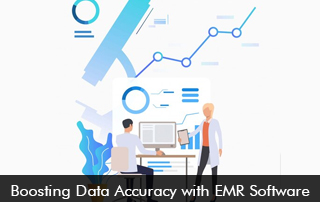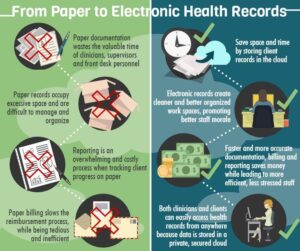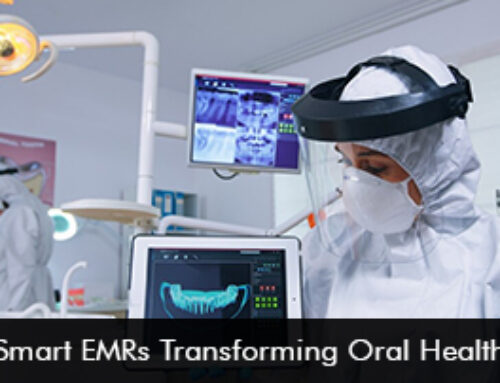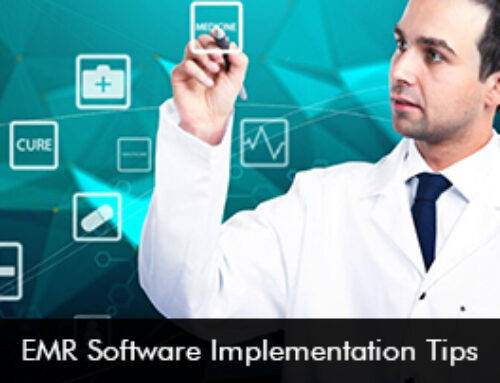EMR software is a cornerstone of healthcare management. Among its many advantages, the ability to significantly improve data accuracy in medical records is the most important one. Accurate and reliable data is essential for providing quality healthcare and making informed decisions ensuring patient safety. Let’s explore how electronic health records (EHR) software boosts data accuracy.
The Importance of Data Accuracy in Healthcare
Data accuracy in healthcare is paramount for several reasons:
Patient Safety: Inaccurate or incomplete medical records lead to medication errors, incorrect diagnoses, and inappropriate treatments, putting patients’ lives at risk.
Quality of Care: Accurate data ensures that healthcare providers have access to the most up-to-date patient information, enabling them to make informed decisions about treatment plans, medications, and interventions.
Continuity of Care: Accurate medical records are crucial for coordinating care among different healthcare providers. When data is consistent and reliable, it ensures that patients receive appropriate treatment, referrals, and follow-up care.
Research and Public Health: Accurate data is essential for medical research and public health initiatives. It helps identify disease trends, assess the effectiveness of healthcare programs, and guide public health policy.
Legal and Regulatory Compliance: Healthcare organizations must comply with various legal and regulatory requirements, including data protection laws like HIPAA (Health Insurance Portability and Accountability Act). Accurate data management is a fundamental aspect of compliance.
The Role of EMR Software in Boosting Data Accuracy
EMR software is designed to overcome the limitations of paper-based medical records and promote data accuracy in several ways:
Eliminating Illegible Handwriting: One of the common issues with paper records is illegible handwriting, which leads to misinterpretation and errors. EMR software resolves this problem by providing clear and typed data entry, ensuring that records are legible and accurate.
Preventing Data Redundancy: Paper records lead to duplication and redundancy, as healthcare providers may create multiple copies of the same record. EMR software prevents this by centralizing patient data, reducing the risk of inconsistencies.
Real-time Data Entry: EMR software allows for real-time data entry, ensuring that records are updated immediately. This leads to accurate and up-to-date patient information that is readily accessible by authorized healthcare professionals.
Decision Support Tools: Many EMR systems include decision support tools that provide alerts and reminders to healthcare providers. These tools help ensure that medical guidelines are followed, reducing the risk of inaccuracies in treatment.
Data Validation and Checks: EMR software often incorporates validation checks that prompt users to input required information and verify data accuracy. These checks reduce the likelihood of incomplete or erroneous records.
Digital Imaging and Attachments: EMR software enables the attachment of digital images and documents, such as X-rays, lab reports, and medical images, to patient records. This allows for more comprehensive and accurate documentation of patient care.
Interoperability: EMR systems can be integrated with other healthcare systems, such as laboratory information systems and pharmacy systems. This integration allows for the seamless exchange of accurate patient data, reducing the risk of discrepancies between systems.
Benefits of EMR Software in Boosting Data Accuracy
The adoption of EMR software is associated with numerous benefits that significantly boost data accuracy:
Reduced Errors: EMR software minimizes the risk of errors, such as illegible handwriting, misplaced records, or data redundancy. This directly contributes to higher data accuracy and better patient care.
Improved Medication Safety: Accurate patient records in EMR software help healthcare providers prescribe the correct medications and dosages. Decision support tools can also flag potential drug interactions or allergies, enhancing medication safety.
Enhanced Patient Engagement: EMR software often includes patient portals that allow individuals to access their medical records and contribute to data accuracy. Patients can review their records, update personal information, and provide valuable input on their healthcare.
Streamlined Workflow: With EMR software, healthcare providers can access patient records quickly, allowing for more efficient clinical workflows. This not only saves time but also reduces the chances of data entry errors.
Data Insights and Analytics: EMR systems provide the tools for data analysis, enabling healthcare organizations to mine patient data for insights and trends. This information can inform evidence-based decisions and quality improvement efforts.
Enhanced Care Coordination: Accurate data in EMR systems facilitates seamless care coordination among various healthcare providers and specialists. Patients receive consistent care, and accurate records support effective referrals and follow-up care.
Regulatory Compliance: EMR software assists healthcare organizations in complying with legal and regulatory requirements. Robust data security measures ensure that patient data is protected in accordance with privacy laws.
Real-World Success Stories
The impact of EMR software on data accuracy is evident in healthcare organizations that have adopted these systems:
Mayo Clinic: The Mayo Clinic, a leading medical institution, implemented EMR software to improve data accuracy and access. They reported a significant reduction in documentation errors, contributing to improved patient care and outcomes.
Kaiser Permanente: Kaiser Permanente, a prominent healthcare provider, has used EMR systems to enhance data accuracy and coordination of care. They have seen a reduction in duplicate records and medication errors, leading to safer and more efficient care.
Cleveland Clinic: The Cleveland Clinic integrated EMR software with decision support tools, reducing the likelihood of diagnostic and treatment inaccuracies. This has resulted in more accurate and timely interventions for patients.
Challenges and Considerations
While EMR software offers substantial benefits in boosting data accuracy, there are challenges and considerations that healthcare providers need to address:
User Training: Healthcare providers must invest in training to ensure that their staff is proficient in using EMR software effectively. User-friendly interfaces and efficient workflows can help with user adoption.
Data Privacy and Security: Safeguarding patient data is of utmost importance. EMR software must adhere to data protection regulations, and healthcare organizations must implement stringent security measures.
Interoperability: Achieving seamless data exchange between different systems and organizations can be a challenge. Standardized data formats and protocols are essential for overcoming interoperability issues.
Cost and Implementation: The initial cost of implementing EMR software, including training, hardware, and software, can be substantial. However, the long-term benefits often outweigh the initial investment.








